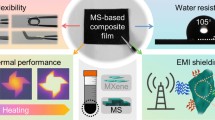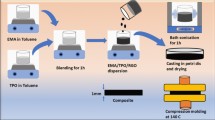Abstract
Electromagnetic interference (EMI) and radiation of electronic devices are ubiquitous, which are potentially hazardous to the normal operation of electronic equipment and human health. MXenes are extremely attractive in the preparation of EMI shielding materials due to their excellent metallic conductivity and tunable surface chemistry. Herein, by virtue of the designed nanostructure and regulation of interface interactions, we fabricated flexible Fe3O4@Ti3C2Tx MXene/3,4-dihydroxyphenylacetic acid (DOPAC)-epoxidized natural rubber (ENR) elastomers (FMDE) with 3D segregated interconnected structures. The elaborately designed metal-ligand coordination crosslinking between Fe3O4 nanoparticles and DOPAC ligand molecules provides strong interfacial interactions, resulting in significantly reinforced mechanical properties. Compared with Ti3C2Tx/ENR elastomers, the maximum tensile strength and toughness of FMDE are elevadted by ~306% and 475%, respectively. Moreover, the 3D segregated conductive network constructed by Fe3O4@Ti3C2Tx nanoflakes resulted from volume exclusion effect of ENR latex and the introduction of magnetic Fe3O4 nanoparticles with enhanced electromagnetic wave absorption greatly improved the EMI shielding performance of FMDE, exhibiting an excellent EMI shielding effectiveness of up to 58 dB in the X band (8.2–12.4 GHz) and stable EMI shielding capability during repeated deformations. This work provides a promising strategy for the design and manufacture of novel flexible EMI shielding materials.

摘要
电磁干扰和辐射无处不在, 可能对电子设备的正常运行和人 体健康造成危害. MXene具有出色的金属导电性和可调的表面化 学, 在屏蔽材料的制备中极具吸引力. 本文通过结构设计和界面调 控, 制备了具有隔离网络结构的柔性Fe3O4@Ti3C2Tx MXene/3,4-二 羟基苯基乙酸(DOPAC)-环氧化天然橡胶(ENR)弹性体(FMDE). Fe3O4与DOPAC配体分子之间的金属-配体配位交联提供了强大的 界面相互作用, 从而显著增强复合材料的机械性能. 与Ti3C2Tx/ENR弹性体相比, FMDE的最大拉伸强度和韧性分别提高了~306% 和~475%. 此外, 借助ENR胶乳的体积排斥效应构建的3D隔离导电 网络, 以及引入的磁性Fe3O4纳米颗粒有效地改善了FMDE的电磁 屏蔽性能, 且证实了FMDE在反复弯曲拉伸后仍具有稳定的电磁屏 蔽能力.
Similar content being viewed by others
References
Abbasi H, Antunes M, Velasco JI. Recent advances in carbon-based polymer nanocomposites for electromagnetic interference shielding. Prog Mater Sci, 2019, 103: 319–373
Shukla V. Review of electromagnetic interference shielding materials fabricated by iron ingredients. Nanoscale Adv, 2019, 1: 1640–1671
Cao MS, Cai YZ, He P, et al. 2D MXenes: Electromagnetic property for microwave absorption and electromagnetic interference shielding. Chem Eng J, 2019, 359: 1265–1302
Kuang T, Chang L, Chen F, et al. Facile preparation of lightweight high-strength biodegradable polymer/multi-walled carbon nanotubes nanocomposite foams for electromagnetic interference shielding. Carbon, 2016, 105: 305–313
Lee J, Liu Y, Liu Y, et al. Ultrahigh electromagnetic interference shielding performance of lightweight, flexible, and highly conductive copper-clad carbon fiber nonwoven fabrics. J Mater Chem C, 2017, 5: 7853–7861
Sambyal P, Iqbal A, Hong J, et al. Ultralight and mechanically robust Ti3C2Tx hybrid aerogel reinforced by carbon nanotubes for electromagnetic interference shielding. ACS Appl Mater Interfaces, 2019, 11: 38046–38054
Feng D, Xu D, Wang Q, et al. Highly stretchable electromagnetic interference (EMI) shielding segregated polyurethane/carbon nanotube composites fabricated by microwave selective sintering. J Mater Chem C, 2019, 7: 7938–7946
Wei Q, Pei S, Qian X, et al. Superhigh electromagnetic interference shielding of ultrathin aligned pristine graphene nanosheets film. Adv Mater, 2020, 32: 1907411
Liang C, Qiu H, Han Y, et al. Superior electromagnetic interference shielding 3D graphene nanoplatelets/reduced graphene oxide foam/epoxy nanocomposites with high thermal conductivity. J Mater Chem C, 2019, 7: 2725–2733
Zhan Z, Song Q, Zhou Z, et al. Ultrastrong and conductive MXene/cellulose nanofiber films enhanced by hierarchical nanoarchitecture and interfacial interaction for flexible electromagnetic interference shielding. J Mater Chem C, 2019, 7: 9820–9829
Mondal S, Ganguly S, Das P, et al. High-performance carbon nanofiber coated cellulose filter paper for electromagnetic interference shielding. Cellulose, 2017, 24: 5117–5131
He W, Zhang R, Cheng Y, et al. Intrinsic elastic conductors with internal buckled electron pathway for flexible electromagnetic interference shielding and tumor ablation. Sci China Mater, 2020, 63: 1318–1329
Yang J, Liao X, Li J, et al. Light-weight and flexible silicone rubber/MWCNTs/Fe3O4 nanocomposite foams for efficient electromagnetic interference shielding and microwave absorption. Compos Sci Tech, 2019, 181: 107670
Liu J, Zhang HB, Sun R, et al. Hydrophobic, flexible, and lightweight MXene foams for high-performance electromagnetic-interference shielding. Adv Mater, 2017, 29: 1702367
Han M, Shuck CE, Rakhmanov R, et al. Beyond Ti3C2Tx: MXenes for electromagnetic interference shielding. ACS Nano, 2020, 14: 5008–5016
Lin H, Chen L, Lu X, et al. Two-dimensional titanium carbide MXenes as efficient non-noble metal electrocatalysts for oxygen reduction reaction. Sci China Mater, 2019, 62: 662–670
Shahzad F, Alhabeb M, Hatter CB, et al. Electromagnetic interference shielding with 2D transition metal carbides (MXenes). Science, 2016, 353: 1137–1140
Sun R, Zhang HB, Liu J, et al. Highly conductive transition metal carbide/carbonitride(mxene)@polystyrene nanocomposites fabricated by electrostatic assembly for highly efficient electromagnetic interference shielding. Adv Funct Mater, 2017, 27: 1702807
Jin X, Wang J, Dai L, et al. Flame-retardant poly(vinyl alcohol)/MXene multilayered films with outstanding electromagnetic interference shielding and thermal conductive performances. Chem Eng J, 2020, 380: 122475
Zhan Y, Wang J, Zhang K, et al. Fabrication of a flexible electromagnetic interference shielding Fe3O4@reduced graphene oxide/natural rubber composite with segregated network. Chem Eng J, 2018, 344: 184–193
He DX, Qiu Y, Li LL, et al. Large-scale solvent-thermal synthesis of graphene/magnetite/conductive oligomer ternary composites for microwave absorption. Sci China Mater, 2015, 58: 566–573
Zhu S, Cheng Q, Yu C, et al. Flexible Fe3O4/graphene foam/poly dimethylsiloxane composite for high-performance electromagnetic interference shielding. Compos Sci Tech, 2020, 189: 108012
Liu P, Yao Z, Ng VMH, et al. Facile synthesis of ultrasmall Fe3O4 nanoparticles on MXenes for high microwave absorption performance. Compos Part A-Appl Sci Manufact, 2018, 115: 371–382
Zhao G, Lv H, Zhou Y, et al. Self-assembled sandwich-like MXene-derived nanocomposites for enhanced electromagnetic wave absorption. ACS Appl Mater Interfaces, 2018, 10: 42925–42932
Wang Y, Gao X, Zhang L, et al. Synthesis of Ti3C2/Fe3O4/PANI hierarchical architecture composite as an efficient wide-band electromagnetic absorber. Appl Surf Sci, 2019, 480: 830–838
Guo Q, Zhang X, Zhao F, et al. Protein-inspired self-healable Ti3C2 MXenes/rubber-based supramolecular elastomer for intelligent sensing. ACS Nano, 2020, 14: 2788–2797
Guo Q, Luo Y, Liu J, et al. A well-organized graphene nanostructure for versatile strain-sensing application constructed by a covalently bonded graphene/rubber interface. J Mater Chem C, 2018, 6: 2139–2147
Zhou Z, Liu J, Zhang X, et al. Ultrathin MXene/calcium alginate aerogel film for high-performance electromagnetic interference shielding. Adv Mater Interfaces, 2019, 6: 1802040
Nguyen VT, Min BK, Yi Y, et al. MXene(Ti3C2Tx)/graphene/PDMS composites for multifunctional broadband electromagnetic interference shielding skins. Chem Eng J, 2020, 393: 124608
Cao Y, Deng Q, Liu Z, et al. Enhanced thermal properties of poly (vinylidene fluoride) composites with ultrathin nanosheets of MXene. RSC Adv, 2017, 7: 20494–20501
Rozmysłowska-Wojciechowska A, Wojciechowski T, Ziemkowska W, et al. Surface interactions between 2D Ti3C2/Ti2C MXenes and lysozyme. Appl Surf Sci, 2019, 473: 409–418
Ghidiu M, Lukatskaya MR, Zhao MQ, et al. Conductive two-dimensional titanium carbide ‘clay’ with high volumetric capacitance. Nature, 2014, 516: 78–81
Filippidi E, Cristiani TR, Eisenbach CD, et al. Toughening elastomers using mussel-inspired iron-catechol complexes. Science, 2017, 358: 502–505
Wang Y, Guo Q, Su G, et al. Hierarchically structured self-healing actuators with superfast light- and magnetic-response. Adv Funct Mater, 2019, 29: 1906198
Holten-Andersen N, Harrington MJ, Birkedal H, et al. PH-induced metal-ligand cross-links inspired by mussel yield self-healing polymer networks with near-covalent elastic moduli. Proc Natl Acad Sci USA, 2011, 108: 2651–2655
Sarycheva A, Gogotsi Y. Raman spectroscopy analysis of the structure and surface chemistry of Ti3C2Tx MXene. Chem Mater, 2020, 32: 3480–3488
Mashtalir O, Naguib M, Mochalin VN, et al. Intercalation and delamination of layered carbides and carbonitrides. Nat Commun, 2013, 4: 1716
Malekani K. Comparison of techniques for determining the fractal dimensions of clay minerals. Clays Clay Miner, 1996, 44: 677–685
Schaefer DW, Zhao J, Brown JM, et al. Morphology of dispersed carbon single-walled nanotubes. Chem Phys Lett, 2003, 375: 369–375
Beaucage G. Small-angle scattering from polymeric mass fractals of arbitrary mass-fractal dimension. J Appl Crystlogr, 1996, 29: 134–146
Koberstein JT, Morra B, Stein RS. The determination of diffuse-boundary thicknesses of polymers by small-angle X-ray scattering. J Appl Crystlogr, 1980, 13: 34–45
Glatter O, Kratky O. Small Angle X-Ray Scattering. London: Academic press, 1982
Jafari A, Farjami Shayesteh S, Salouti M, et al. Effect of annealing temperature on magnetic phase transition in Fe3O4 nanoparticles. J Magn Magn Mater, 2015, 379: 305–312
Rahman O, Mohapatra SC, Ahmad S. Fe3O4 inverse spinal super paramagnetic nanoparticles. Mater Chem Phys, 2012, 132: 196–202
Yang S, Cao C, Sun Y, et al. Nanoscale magnetic stirring bars for heterogeneous catalysis in microscopic systems. Angew Chem, 2015, 127: 2699–2702
Ren J, Shen S, Pang Z, et al. Facile synthesis of superparamagnetic Fe3O4@Au nanoparticles for photothermal destruction of cancer cells. Chem Commun, 2011, 47: 11692–11694
Wang XX, Ma T, Shu JC, et al. Confinedly tailoring Fe3O4 clusters-NG to tune electromagnetic parameters and microwave absorption with broadened bandwidth. Chem Eng J, 2018, 332: 321–330
Zhang M, Wang M, Zhang M, et al. Stretchable conductive Ni@Fe3O4@polyester fabric strain sensor with negative resistance variation and electromagnetic interference shielding. Org Electron, 2020, 81: 105677
Xiang C, Guo R, Lin S, et al. Lightweight and ultrathin TiO2-Ti3C2Tx/graphene film with electromagnetic interference shielding. Chem Eng J, 2019, 360: 1158–1166
Li X, You W, Wang L, et al. Self-assembly-magnetized MXene avoid dual-agglomeration with enhanced interfaces for strong microwave absorption through a tunable electromagnetic property. ACS Appl Mater Interfaces, 2019, 11: 44536–44544
Shen B, Zhai W, Tao M, et al. Lightweight, multifunctional polyetherimide/graphene@Fe3O4 composite foams for shielding of electromagnetic pollution. ACS Appl Mater Interfaces, 2013, 5: 11383–11391
Li P, Du D, Guo L, et al. Stretchable and conductive polymer films for high-performance electromagnetic interference shielding. J Mater Chem C, 2016, 4: 6525–6532
Liu Z, Wan F, Mou L, et al. A general approach for buckled bulk composites by combined biaxial stretch and layer-by-layer deposition and their electrical and electromagnetic applications. Adv Electron Mater, 2019, 5: 1800817
Acknowledgements
This work was supported by the National Natural Science Foundation of China (51861165203), China Postdoctoral Science Foundation (2019M653398) and Sichuan Science and Technology Program (2020YJ0261). We would like to thank the Analytical & Testing Centre of Sichuan University for XPS, TEM and we would be grateful to Guiping Yuan for her help in TEM characterization. We also thank Shiyanjia Lab (www.shiyanjia.com) for the support of VSM and XRD test.
Author information
Authors and Affiliations
Contributions
Lu C and Zhou Z were responsible for the experimental concept and design; Song Q and Chen B carried out most of the experiments, characterization and data analyses. Song Q wrote the paper with support from Lu C and Zhou Z. All authors contributed to the general discussion.
Corresponding authors
Additional information
Conflict of interest
The authors declare no conflict of interest.
Quancheng Song is currently a Master candidate under the supervision of Prof. Lu at the State Key Laboratory of Polymer Materials Engineering, Sichuan University. His research interest focuses on the flexible polymer functional composite materials.
Zehang Zhou is currently a postdoctoral researcher at the State Key Laboratory of Polymer Materials Engineering, Sichuan University. He received his PhD in materials science and engineering from Sichuan University in 2018. He worked as a visiting researcher in the Department of Materials Science and Engineering, University of Philadelphia from 2015 to 2017. His research interests focus on the fabrication and application of polymer functional composite materials and natural polymer composite.
Canhui Lu is currently a professor at the State Key Laboratory of Polymer Materials Engineering, Polymer Research Institute of Sichuan University. He received his PhD from Sichuan University in 2002. His research areas include polymer blends and composites, design and fabrication of nanocellulose-based electrochemical energy storage devices, flexible triboelectric nanogenerators for self-powered functional electronics, and polymer solid phase mechanochemistry and highly filled polymer composites.
Supplementary Information
40843_2020_1539_MOESM2_ESM.pdf
Flexible, stretchable and magnetic Fe3O4@Ti3C2Tx/elastomer with supramolecular interfacial crosslinking for enhancing mechanical and electromagnetic interference shielding performance
Rights and permissions
About this article
Cite this article
Song, Q., Chen, B., Zhou, Z. et al. Flexible, stretchable and magnetic Fe3O4@Ti3C2Tx/elastomer with supramolecular interfacial crosslinking for enhancing mechanical and electromagnetic interference shielding performance. Sci. China Mater. 64, 1437–1448 (2021). https://doi.org/10.1007/s40843-020-1539-2
Received:
Accepted:
Published:
Issue Date:
DOI: https://doi.org/10.1007/s40843-020-1539-2




